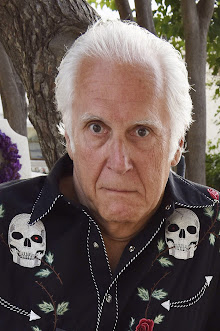This is a torii, a Shinto structure through which the Gods enter.
You'll find a torii in front of every Shinto shrine in Japan. You'll also see them free-standing, like this one, wherever there seems to be a vortex of kami, or spirits of place. Many of them stand in seawater, either in the ocean or in bays.
Shinto is perhaps the oldest Japanese religion and the closest to being home-grown, although the name is taken from two Chinese words, shin, meaning "spirit," and to, which is a derivative oftao (as in Taoism), meaning a path or a course of study. So I suppose you could say it's a spiritual path of study. It's sometimes translated as "the way of the gods."
Despite the borrowing of Chinese words -- probably chosen because Japan never invented a written language of its own but instead appropriated the character-based system of the Chinese -- Shinto is Japanese to its roots. The Shinto creation story is essentially the story of the creation of Japan. In it, two powerful kami, Izanami and Izanagi, were deputed by other gods to create the world. After some trial and error, they created the eight islands that became known as Japan.
Izanami and Izanagi creating Japan on the ocean
Therefore, Shinto holds Japan itself as sacred. It further holds that kami are to be found in all aspects of the natural world and that the natural world is therefore the source of beauty and goodness. Nature is sacred. To be removed from nature is to be far from the gods.
Shinto gods have no investment in morality. They do not judge or punish. Human suffering, presently so abundant in Japan, is not seen as punishment but as a state that is sometimes unavoidable. In times of suffering, people might go to a shrine and seek purification. Most Shinto shrines are built to house an especially strong or vital kami, and therefore they literally mark places that are rich in spirit.
A visit to a shrine actually begins with a ritual cleaning. There is a basin outside virtually all Shinto shrines.
Here is how it should be used.
Hands and mouth should be washed thoroughly. Cleanliness is an important aspect of Shinto.
Then one may ring a bell or clap one's hands and pray.
The purpose of prayer is not to atone for past wrongs or to avoid future misfortune. It is to strengthen one's connection with the earth, with the source of spirit, and to hasten the reestablishment of one's own equilibrium. It also may help turn away the influence of mischievous spirits.
Once one has visited the temple, one is supposed to behave properly, which in Shinto means in a way that furthers the aims and the harmony of the group. This probably explains the extraordinary behavior of the Japanese in the wake of the recent disasters.
These are pictures of Shinto Shrines at Fukushima, neither of which may be standing now.
One of the first things that strikes me when I look at Shinto shrines is how they mirror the Japanese aesthetic of natural simplicity, an aesthetic that clearly has its roots in the belief that the natural world is the source of spirituality.
Shinto is not an exclusive religion. It recognizes the multitudes of angels, demons, messiahs, saints, and spiritual leaders from other religions as kami. Most Japanese, if asked, would probably say they practice both Shinto and Buddhism.
But there's a functional division between the two. Shinto, which doesn't really touch on the afterlife, is the religion of daily life, while Buddhism is the religion (at least in part) of the afterlife. Most Japanese weddings are Shinto ceremonies, but almost all funerals are Buddhist.
I'm certain that Buddhism is much on the minds of the Japanese today.
I'll Be Home For Christmas
3 hours ago






















What a beautiful explanation of Eastern religion, especially at this time, for Japan.
ReplyDeleteI knew a man who sat as a child with his mother on the mountains outside of Tokyo watching the last days of World War II. I understand his grandfather was a well-respected Shinto priest, his father an emissary of the Emperor to Great Britain, and his mother a distinguished writer.
ReplyDeleteHe came to the United states in the 1950's. I knew him only as a quiet, slight man. Hard to imagine he trained the Boston Police Department on methods of self defense and practiced shiatsu as a master of the masters. He was a man at peace with himself and the world about him.
Regrettably, I've not seen him in years but I'm certain today he is crying.
Perhaps this explains the quiet, graceful behavior of the Japanese in the light of the awful destruction they have experienced. I'm sure they are grieving. This is beyond comprehension. (Hi Tim, I've been reading this since I discovered all the writers on this blog. Fine reading for me.)
ReplyDeleteThanks, Book Dilettante -- The problem is getting the writing down to this length because there's so much that could be said about Shinto and its place in Japanese consciousness. The whole floral art of ikebana, the simplicity of ink- painting, the cleanliness of the Japanese peopke -- all these are manifestations of Shinto. And a thousand others.
ReplyDeleteAnd for a while its focus on Japan as the gods' chosen world was used as a rationale for militarism. But today the religion's original emphasis on inner and out peace, which was suppressed for much of the first half of the 20th century, is once again being emphasized.
Hi, Jeffrey, and I envy you your acquaintance with that man. Someone like that stays with you always.
Thank you, Lil -- you're, as always, a ray of light,